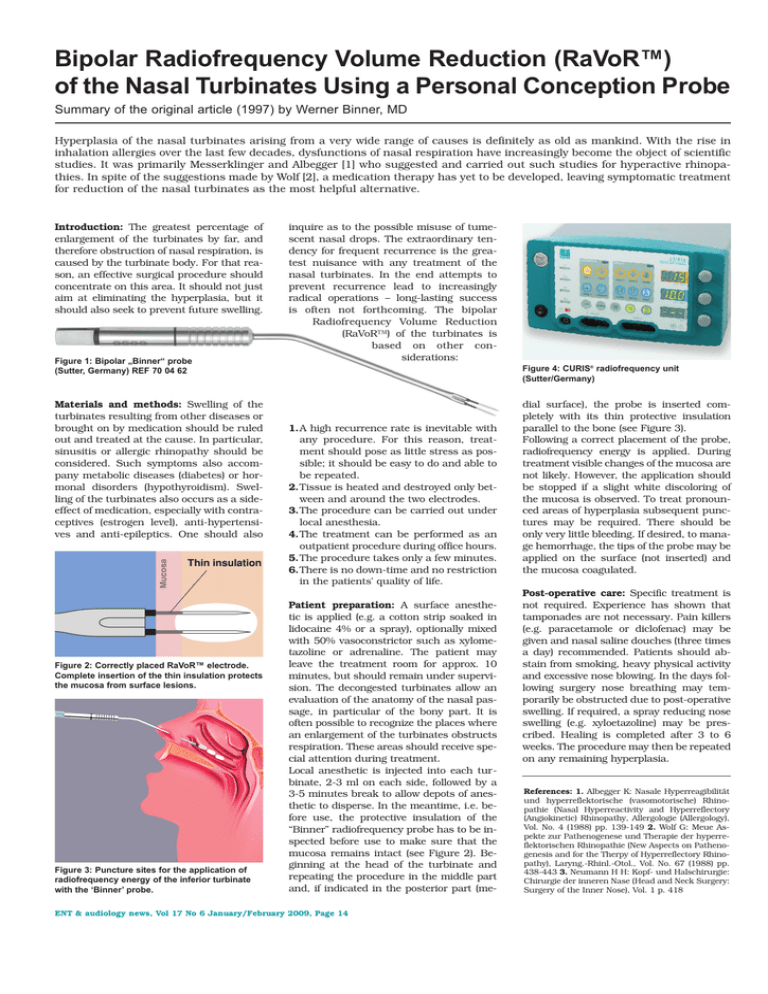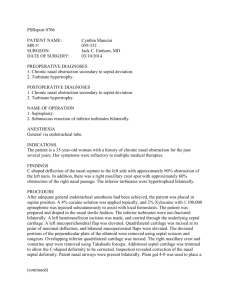Bipolar Radiofrequency Volume Reduction (RaVoR™) of the Nasal
advertisement

Bipolar Radiofrequency Volume Reduction (RaVoR™) of the Nasal Turbinates Using a Personal Conception Probe Summary of the original article (1997) by Werner Binner, MD Hyperplasia of the nasal turbinates arising from a very wide range of causes is definitely as old as mankind. With the rise in inhalation allergies over the last few decades, dysfunctions of nasal respiration have increasingly become the object of scientific studies. It was primarily Messerklinger and Albegger [1] who suggested and carried out such studies for hyperactive rhinopathies. In spite of the suggestions made by Wolf [2], a medication therapy has yet to be developed, leaving symptomatic treatment for reduction of the nasal turbinates as the most helpful alternative. Introduction: The greatest percentage of enlargement of the turbinates by far, and therefore obstruction of nasal respiration, is caused by the turbinate body. For that reason, an effective surgical procedure should concentrate on this area. It should not just aim at eliminating the hyperplasia, but it should also seek to prevent future swelling. Figure 1: Bipolar „Binner“ probe (Sutter, Germany) REF 70 04 62 Materials and methods: Swelling of the turbinates resulting from other diseases or brought on by medication should be ruled out and treated at the cause. In particular, sinusitis or allergic rhinopathy should be considered. Such symptoms also accompany metabolic diseases (diabetes) or hormonal disorders (hypothyroidism). Swelling of the turbinates also occurs as a sideeffect of medication, especially with contraceptives (estrogen level), anti-hypertensives and anti-epileptics. One should also Figure 2: Correctly placed RaVoR™ electrode. Complete insertion of the thin insulation protects the mucosa from surface lesions. Figure 3: Puncture sites for the application of radiofrequency energy of the inferior turbinate with the ‘Binner’ probe. inquire as to the possible misuse of tumescent nasal drops. The extraordinary tendency for frequent recurrence is the greatest nuisance with any treatment of the nasal turbinates. In the end attempts to prevent recurrence lead to increasingly radical operations – long-lasting success is often not forthcoming. The bipolar Radiofrequency Volume Reduction (RaVoR™) of the turbinates is based on other considerations: Figure 4: CURIS® radiofrequency unit (Sutter/Germany) 1.A high recurrence rate is inevitable with any procedure. For this reason, treatment should pose as little stress as possible; it should be easy to do and able to be repeated. 2.Tissue is heated and destroyed only between and around the two electrodes. 3.The procedure can be carried out under local anesthesia. 4.The treatment can be performed as an outpatient procedure during office hours. 5.The procedure takes only a few minutes. 6.There is no down-time and no restriction in the patients’ quality of life. Patient preparation: A surface anesthetic is applied (e.g. a cotton strip soaked in lidocaine 4% or a spray), optionally mixed with 50% vasoconstrictor such as xylometazoline or adrenaline. The patient may leave the treatment room for approx. 10 minutes, but should remain under supervision. The decongested turbinates allow an evaluation of the anatomy of the nasal passage, in particular of the bony part. It is often possible to recognize the places where an enlargement of the turbinates obstructs respiration. These areas should receive special attention during treatment. Local anesthetic is injected into each turbinate, 2-3 ml on each side, followed by a 3-5 minutes break to allow depots of anesthetic to disperse. In the meantime, i.e. before use, the protective insulation of the “Binner” radiofrequency probe has to be inspected before use to make sure that the mucosa remains intact (see Figure 2). Beginning at the head of the turbinate and repeating the procedure in the middle part and, if indicated in the posterior part (me- ENT & audiology news, Vol 17 No 6 January/February 2009, Page 14 dial surface), the probe is inserted completely with its thin protective insulation parallel to the bone (see Figure 3). Following a correct placement of the probe, radiofrequency energy is applied. During treatment visible changes of the mucosa are not likely. However, the application should be stopped if a slight white discoloring of the mucosa is observed. To treat pronounced areas of hyperplasia subsequent punctures may be required. There should be only very little bleeding. If desired, to manage hemorrhage, the tips of the probe may be applied on the surface (not inserted) and the mucosa coagulated. Post-operative care: Specific treatment is not required. Experience has shown that tamponades are not necessary. Pain killers (e.g. paracetamole or diclofenac) may be given and nasal saline douches (three times a day) recommended. Patients should abstain from smoking, heavy physical activity and excessive nose blowing. In the days following surgery nose breathing may temporarily be obstructed due to post-operative swelling. If required, a spray reducing nose swelling (e.g. xyloetazoline) may be prescribed. Healing is completed after 3 to 6 weeks. The procedure may then be repeated on any remaining hyperplasia. References: 1. Albegger K: Nasale Hyperreagibilität und hyperreflektorische (vasomotorische) Rhinopathie (Nasal Hyperreactivity and Hyperreflectory (Angiokinetic) Rhinopathy, Allergologie (Allergology), Vol. No. 4 (1988) pp. 139-149 2. Wolf G: Meue Aspekte zur Pathenogenese und Therapie der hyperreflektorischen Rhinopathie (New Aspects on Pathenogenesis and for the Therpy of Hyperreflectory Rhinopathy), Laryng.-Rhinl.-Otol., Vol. No. 67 (1988) pp. 438-443 3. Neumann H H: Kopf- und Halschirurgie: Chirurgie der inneren Nase (Head and Neck Surgery: Surgery of the Inner Nose), Vol. 1 p. 418 Featured Product 1:1 870010 – CURIS® basic set with single-use patient plates Qty. REF Description 1 360100-01 CURIS® radiofrequency generator (incl. mains cord, user manual and test protocol) 1 360110 Footswitch with two pedals for CURIS® (cut & coag), 4 m cable 1 370154 L Bipolar cable for CURIS®, length 3 m 1 360704 Monopolar handpiece (pencil) cut & coag, shaft 2.4 mm, cable 3 m 1 360236 Cable for single-use patient plates, length 4.5 m 1 (x50) 360222 Safety patient plates, single use, packing 5 x 10 pcs. (not shown) *Optional model CURIS® basic set with re-usable patient plate (REF 870020) S UTTER M EDI Z I NTECH N I K GM BH T U L L A S T R A S S E 87 · 7910 8 F R E I B U R G / G E R M A N Y · T E L . + 4 9 ( 0 ) 761 515 51 - 0 · FA X + 4 9 ( 0 ) 761 515 51 - 3 0 W W W. S U T T E R - M E D . C O M · W W W. S U T T E R - M E D . D E · E - M A I L : I N F O @ S U T T E R - M E D . D E © Sutter Medizintechnik · Subject to change · REF 1072 – J09 · printed on acid free paper 700462 – Bipolar needle electrode "Binner" Qty. REF Description 1 700462 Bipolar needle electrode "Binner" with protective insulation, work lengh 110 mm


